
Important Radar Recalibration Announcement
As many folks are aware, the north magnetic pole is migrating. What many people don’t realize is that they need to calibrate their radar units so when in “north-up” display mode, things are accurate. We recently hired a radar technician specialist and he walked us through the process. It was simple enough, and we share the procedure for your navigational safety. It’s quite similar to boxing a compass, but with radar instead.
Turn on the radar unit, and after warmup, initiate transition and zoom in to the closest range. You’ll need two people to conduct this part of the calibration: one to run the unit and one to row around the boat, or walk around using nearby piers and parking lots.
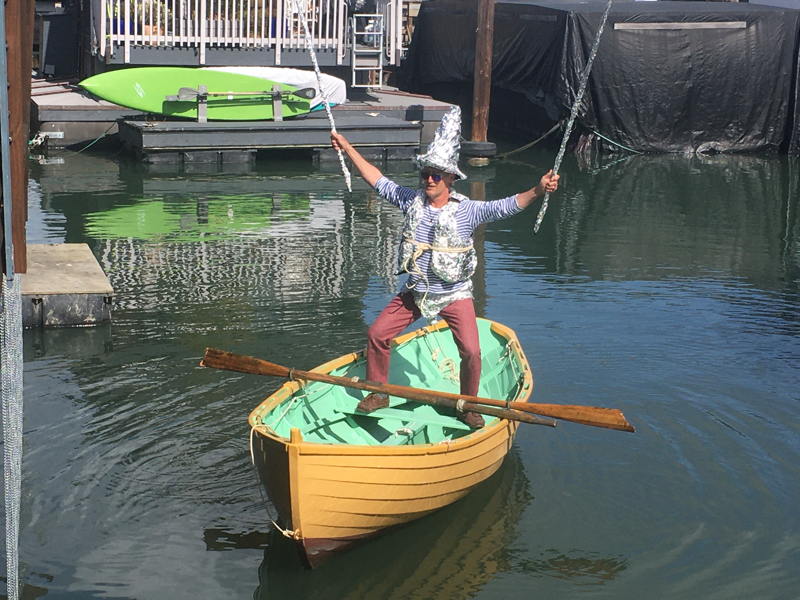
First, use the dull side of aluminum foil and wrap it around one arm of your assistant; on the other arm, use the shiny side. Be generous with both. Additionally, make a hat of the same material, shiny side out. This will provide a better radar return if in the harbor.
The key to this next step is to have your crewman circle the boat at varying distances, say, 50 feet, 100 feet and 150 feet, slowly advancing in a clockwise direction and then a counterclockwise direction three or four times, and at each cardinal point rotating in place with arms out, again in a sunwise direction. The difference between the counter-rotating shiny side and dull side will help establish the polarity parallax and is used to recalibrate true north. This can be verified by repeating the exercise.
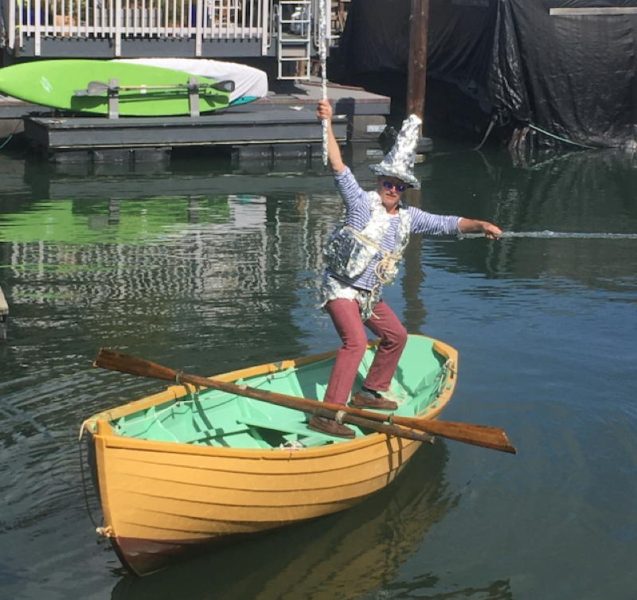
For details on your specific unit be sure to refer to your owner’s manual for your unit. Under the menu bar is a field called “recalibration of radar polarity.”
And just like that we’re all set for another 10 years of happy sailing.
Thanks, Captain Paul
‘Bottoms Up’ — First Boat To Be Made of Dryer Lint
Greetings from Humboldt County, where the weed is fresh and the beer can be cold. Although I am young at heart, I am a longtime Latitude reader who looks forward each month to a unique perspective on all things sailing and boatbuilding.
I am waiting to hear from Cal Maritime about my acceptance into an Applied Arts program I want to start next year. Meanwhile, as I wait for my acceptance letter, I have taken to reading as much as I can about boatbuilding, and really like Phil Bolger designs. Now I have a plan to build and live on a Bolger-designed Loose Moose, a creative 38-ft go-anywhere boat that I want to name Bottoms Up after my grandmother’s stage name when she worked at the Condor in San Francisco in the late 1950s.
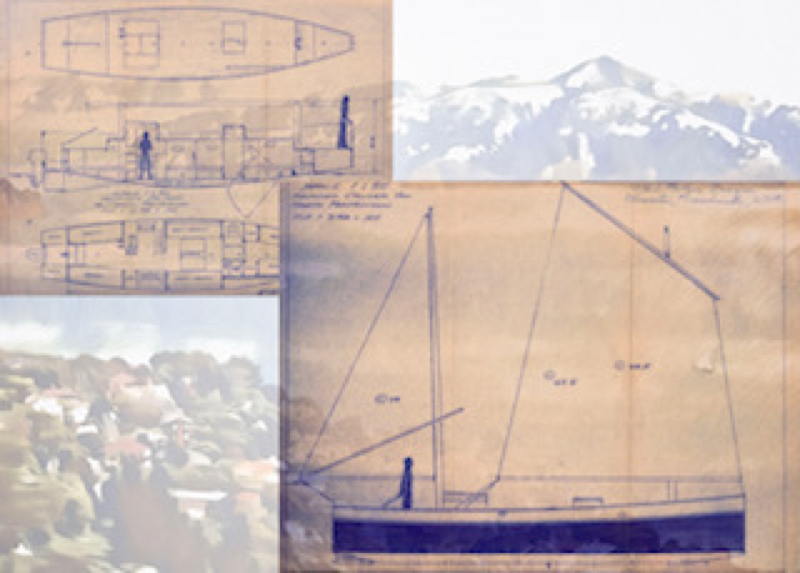
As a visual artist, beach-sand sculptor, and hollow-log drummer in tune with nature, I am concerned about putting toxics into the environment, so I want to use locally sourced materials that are sustainable. After seeing the increases in the cost of new lumber, I think I have come across some materials that will make the basis of a sound hull and a great sailer. Over the years, I have gotten concerned about the amount of plastic going into our oceans, our landfills, and into animals’ and our bodies. In a recent news article I read there is a Ziploc lunch bag of plastic in our brains already. I know that plastics are a real problem, and the best way to deal with them is to use them again, rather than just throw them away.
During the winter, when I can take time away as a cutter and trimmer for the season, I often come down to Sausalito, and by accident have struck up friendships with men such as Captain Paul Dines, Davy Jones and Jamie White, who are respected in the boating and maritime scene, and who I do hope will become my mentors in finding my footing and building here. They all suggested I write a letter to Latitude 38 for assistance in not only finding a free work space in Sausalito that will need to be big enough for a 38-ft build, but also a donated good truck to use, and a living place for me, my girlfriend, and our three rescue dogs.
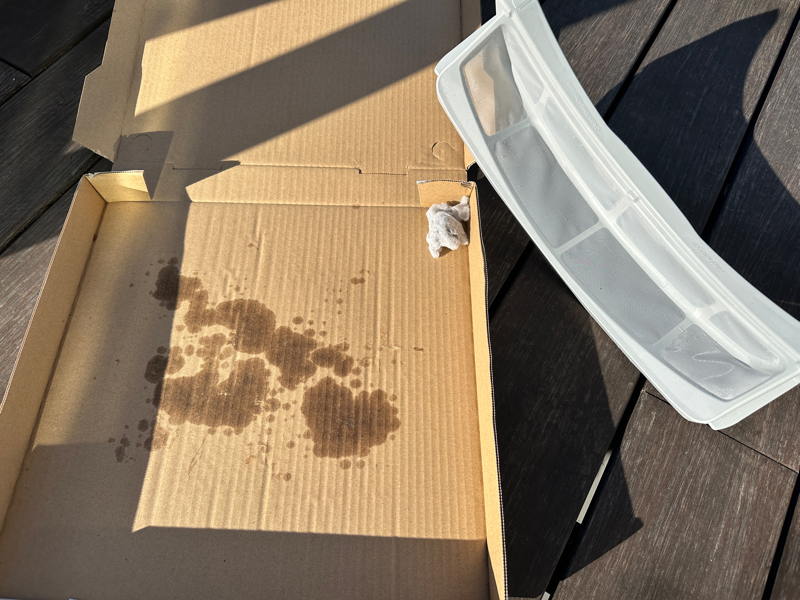
Since I am planning to make my boat out of community-sourced, donated dryer lint, old T-shirts and older open cans of epoxy, I am going to need to set up collection facilities. It would really be a great help if I could use the Latitude 38 offices as our drop-off location until we are able to bring all the materials over under one roof. I am working on ways to separate the hair from the polyester and wool and use it for other materials in my build. Any other technological help or hand would further be greatly appreciated. I am also looking for an experienced social media specialist who is good with computers, fundraising and other things to make this a success.

It is my goal to have this boat done before I start my second winter semester at Cal Maritime, so I have a place to live while I finish up school and before starting my new family. It is my goal to not only build this boat to prove that locally sourced dryer lint and old liquid polymers can make a world-saving vessel, but to travel on her around the world in representation of locally sustainable building from recycled and upcycled materials.
Thank you for your help.
Teddy Daidreamer Hoppe
SV Bottoms Up, Sausalito and (soon) the World.
Coolers Can Save Boaters’ Lives
There has been a rash of boat sinkings and rescues where a non-purpose-built piece of equipment has played a key role in people’s survival: coolers.
A search of the internet found numerous cases of boaters being rescued by the only floating object available — their styrofoam-insulated cooler.
Last October, a captain survived a night in a hurricane west of Longboat Key in Florida. The US Coast Guard announced, “He survived because of a life jacket, his emergency position indicating radio beacon (EPIRB), and a cooler.” Another story described how eight people were rescued after their 28-ft boat sank 40 miles west of Florida in the Gulf of Mexico. They managed a mayday call before the boat went down and the USCG found them all alive, clinging to a cooler. Another four people were rescued by clinging to two coolers after the boat sank. (They’d posted their goodbye message to family on TikTok.) A separate Florida rescue involved four fishermen who clung to a cooler for 3–4 hours after their 16-ft fishing boat capsized. Two men were rescued while clinging to a cooler in Boston Harbor after their boat sank.
This has spawned a rush of product development in wearable and throwable life-saving coolers. The smaller versions are just large enough to hold a six-pack and ice, while larger versions will hold up to a case plus a couple of good-sized cod. Both have side pockets for Slim Jims or beef jerky.

While researching the history of rescues by cooler we was discovered that the design of the original, unsinkable 13-ft Boston Whaler was inspired by a New England cod fisherman. It was in Gloucester, MA, that a fishing boat went down in a storm with the sole occupant surviving by strapping a small outboard to one end of the large cod icebox and motoring to safety. The ice box prototype was a successful development and one of the reasons the Boston Whaler ditched the pointed bow in favor of a rectangular hull shape.
While many products are still being field tested, it’s a reminder you should never leave the dock without a full cooler. If someone shouts, “Throw the cooler,” it’s an indication they may need rescue, or perhaps another drink while in the drink.
Alien Encounters on the High Seas
We are not alone in the universe!
On February 26, a USCG/Department of Homeland Security press release read: Coast Guard encounters over a dozen aliens off the coast of southern California.
How was this not bigger news?
After centuries of speculation and generations of fiction imagining other worlds and new beings, suddenly — on a Tuesday morning — the Coast Guard made first contact somewhere off SoCal.
Will the world ever be the same? Surely, something of this magnitude would forever change humanity.
Star Trek posited that after making first contact with an alien species, the nagging problems plaguing humanity vanished, or rather, humanity abandoned war and strife and instead sought to embrace what was beyond Earth. Aliens opened the door to a utopia.
Or maybe an alien encounter would be more like Star Wars, where war and strife were taken to the stars. (Not to worry, the bad guys have terrible aim.) Or maybe the alien encounter would be more like Watchman, where a false-flag attack from an extraterrestrial brought the US and Russia (still the USSR) back from the brink of nuclear war — uniting two foes against a common external threat.
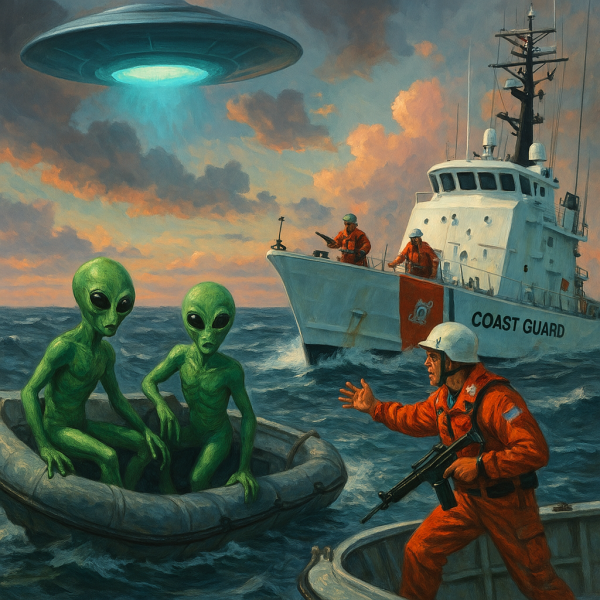
Juxtaposing the Coast Guard’s previous press release, on January 21, a USCG headline read: Coast Guard interdicts 26 migrants near Oceanside Harbor. “Coast Guard crews interdicted a panga-style vessel. A boarding team safely embarked the 26 individuals who represented multiple nationalities, including those from Mexico, China and Vietnam,” a press release said.
The alien event on February 26 was, of course, a near-identical situation: The Coast Guard said that three assets “participated in the encounter … [Coast Guard] crewmembers turned over custody of the aliens, including Mexican, Chinese, and Indian nationals, to Customs and Border Protection for further processing.”
The Coast Guard added in the February release that they “work closely with federal and international partners to disrupt human smuggling operations and ensure the safety of those at sea.”
Latitude considered asking the Coast Guard about the language change, but decided against it. That would have been inappropriate. The Coast Guard is just following orders … and they have better things to do, like saving lives.
Clearly, the language change came from high above.
The day after the new administration was sworn in, the acting director of US Immigration and Customs Enforcement issued a memo directing ICE to use “alien” instead of “noncitizen” in all communications, rescinding previous guidance from 2021. “Alien” had long been the legal term in federal law but had fallen out of favor in some agencies due to its negative connotations. This is only natural — language is dynamic and has always evolved with time.
Being the starving writers that we are, we here at Latitude believe in the importance of words. We are open to words changing our minds, and we hope that our own words might give people who don’t agree with us something to ponder. Believing in language is a little like believing in life outside Planet Earth, though — it requires faith and hope, and it’s a little scary. Who knows if the message will be received?
Language can be manipulated (both sides do it) and set-in-the-stone morals can be flip-flopped. (Liberals now hate Teslas and conservatives love them.) Who is the enemy? (Those fu@king Canadians?) Whom are we afraid of? And where does that fear come from? From the words we read, or from what’s happening in our everyday lives?
We thank the Coast Guard for watching after migrants, aliens, extraterrestrials, individuals, commercial mariners and pleasure boaters with equal care and skill.
